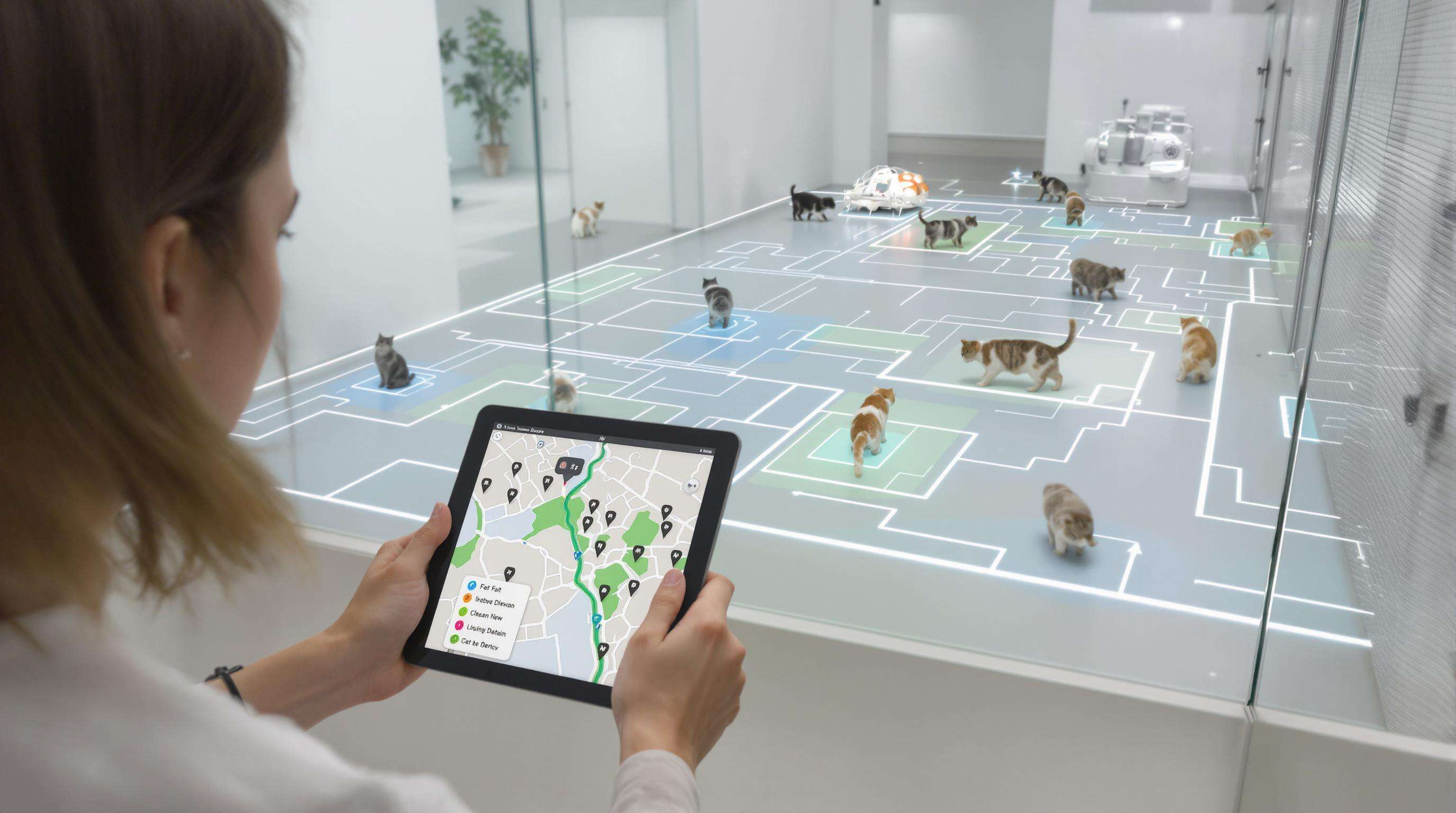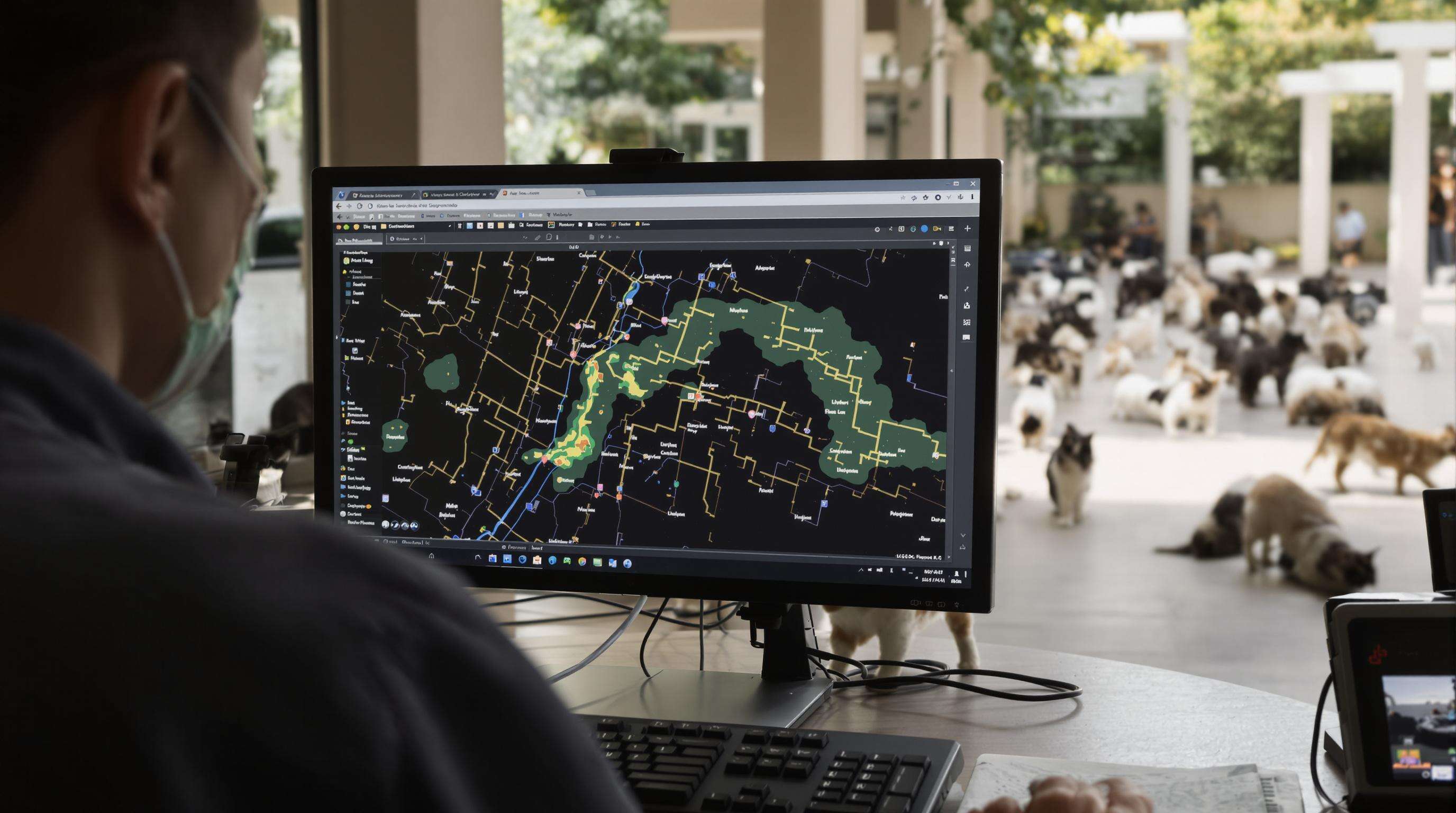How Cat Tracker Geofencing Supports Shelter Management
Understanding Cat Tracker Geofencing and Its Role in Shelters
Geofencing for cat trackers is now pretty much essential at most animal shelters these days. The tech basically works by setting up invisible fences using GPS so shelters can keep tabs on where their cats are going. Staff members get alerts on their phones whenever a kitty gets too close to the edge of whatever area they've marked off as safe territory. Many shelters have noticed that this helps keep those clever escape artists contained better than old fashioned cages ever could. Plus, cats seem less stressed out in these setups since they still have some freedom to move around within designated spaces rather than being locked up all day long.
What Is Cat Tracker Geofencing and How It Works
GPS technology combined with cell phone networks lets shelters create invisible fences right from their smartphones. The lightweight tracking collars send out where kitty is going whenever they get close to those set areas. Better versions actually learn from how fast cats move around or which directions they tend to go, cutting down accidental alerts by roughly 40 percent when multiple cats are running around together. This makes life easier for shelter workers who don't want to chase after every meow that sounds like an emergency but isn't really one.
Integration of Geofencing Technology in Pet GPS Trackers
Shelters prioritize trackers with modular geofencing features that integrate with existing shelter management software. Unlike consumer-grade pet devices, shelter-grade systems offer:
- Multi-zone mapping for complex facilities
- Bulk alert management for staff rotations
- Historical movement analysis compatible with veterinary records
Key Differences Between Cat-Specific GPS Trackers and General Pet Trackers
| Feature | Cat Trackers | General Pet Trackers |
|---|---|---|
| Weight | <15g (neck-safe for cats) | 50-100g (dog-optimized) |
| Battery Life | 14-21 days (low-energy) | 7-10 days (continuous GPS) |
| Boundary Precision | 3-meter accuracy | 5-10 meter accuracy |
| Water Resistance | IP67 (withstands grooming) | IPX7 (brief submersion) |
Specialized cat trackers account for feline behaviors like climbing and tight-space navigation, with 78% of shelters reporting higher adoption rates for cats using these systems compared to traditional ID tags.
Preventing Cat Escapes and Enhancing Shelter Safety with Geofencing Alerts

Real-Time Location Tracking and Instant Notifications for Shelter Cats
Geofencing systems for cat trackers keep tabs on indoor cats all day long through GPS tracking. When these furry friends get too close to set boundaries, their humans get immediate warnings either by text message or through a mobile app. The ability to spot escape attempts right away makes a big difference, especially at city animal shelters where cats are in danger from cars and wild animals. According to research published last year, shelters that implemented geofencing tech managed to catch runaway cats 62 percent quicker than those relying on old fashioned watchful waiting approaches. That kind of improvement can literally save lives in busy urban areas.
Using Geofencing to Prevent Escapes and Manage High-Risk Cats
Many animal shelters now set up invisible fences around dangerous spots such as loading zones or places where windows are left open. When dealing with those stubborn escape artists among cats, which makes up about 15% of shelter cats based on some ASPCA numbers, staff members tend to shrink down the electronic boundary area to somewhere between 30 and 50 feet away from these trouble spots. They also turn on extra warning layers so they know when something gets too close. The whole system works pretty well actually, letting workers focus their attention where it matters most without completely cutting off outside time for the cats participating in special enrichment activities.
Case Study: Reducing Lost Cat Incidents in Urban Shelters
A mid-sized Chicago shelter implemented geofencing trackers across its 120-cat facility, creating zone-specific boundaries with these results over 6 months:
| Metric | Pre-Implementation | Post-Implementation |
|---|---|---|
| Escapes/month | 9.2 | 3.1 |
| Staff time spent searching | 14 hrs/week | 5 hrs/week |
| Stress-related illnesses | 27% of cats | 11% of cats |
Activity logs revealed 83% of escapes occurred during cleaning hours, prompting procedural changes to limit facility access points.
Balancing Technology and Physical Containment: Avoiding Over-Reliance on Geofencing
Geofencing has been shown to cut down on escape attempts by around 40 to 60 percent according to some studies, but animal shelters still need strong physical barriers as their main way of keeping animals contained. The best setup usually includes things like GPS tracking collars that can come off if needed, along with double doors at entrances and regular checks of fences for damage. Tech should really be thought of as something extra, not a substitute for good old fashioned security measures. This idea is backed up by findings from the Animal Shelter Operations Report released last year, which found that shelters using both tech and traditional methods had about 72 percent fewer problems with animals getting out compared to those relying solely on one method or the other.
Improving Shelter Operations with Data from Cat Tracker Geofencing

Using Individual Cat Movement Data for Resource Allocation and Staff Planning
Geofencing technology for cat trackers helps animal shelters manage their resources around 23 percent better when looking at how cats move between indoor and outdoor spaces. These tracking devices show which felines hang out in the social areas compared to those that stick to their own territory, so staff can tweak work schedules, plan better enrichment activities, and adjust feeding times accordingly. According to research from the Animal Welfare Institute last year, shelters that implemented this kind of data saw monthly savings on overtime expenses amounting to about $1,200, plus they noticed an 18 point increase in successful cat socializations. Makes sense really, since knowing where each cat spends its time just makes everything run smoother.
Analyzing Movement Trends to Optimize Shelter Layout and Cat Management
Heatmap technology from geofencing helps animal shelters spot areas nobody goes near and figure out where all the action happens. This info guides them when they need to redesign facilities so those skittish or aggressive cats don't get stressed out as much. Looking at how often cats actually use their litter boxes (somewhere between six and fourteen times each day) plus tracking water station activity tells staff exactly where to put these essentials. Many shelters have seen real improvements after implementing these spatial analysis techniques. One particular shelter reported getting cats adopted 31 percent quicker simply by putting together groups of compatible felines in specially arranged living spaces that work better for everyone involved.
Scaling Shelter Management with B2B Cat Tracker Geofencing Solutions
Big enterprise geofencing systems bring together data from over 200 trackers and display everything on dashboards that show how many cats are in each enclosure right now plus send automatic reminders when someone needs checking on. The batch configuration feature lets managers update settings for several cat groups at once, which becomes really important when there are those seasonal spikes in new arrivals. Some of the better systems actually work with vet software too, so they can spot when older cats start moving around less than normal. This early warning system cut down on emergency situations by almost half according to tests run last year.
Tailoring Geofencing Strategies for Different Cat Populations in Shelters
Modern shelters leverage cat tracker geofencing to address diverse feline needs while maintaining operational efficiency. A 2023 study in Journal of Feline Welfare found shelters using customized virtual boundaries reduced containment breaches by 42% across 1,200 cases, highlighting the importance of population-specific strategies.
Supporting Outdoor Access Programs with Secure Geofencing Zones
Many animal shelters now let cats enjoy some fresh air while keeping them safe through adjustable geofencing technology. These systems work by putting GPS collars on the cats that set up invisible boundaries around specific outdoor spaces. The zones usually range from about 200 to 500 feet, and when a cat gets too close to something dangerous like a busy road, the system sends out an alert. According to data from last year's Urban Shelter Report, roughly seven out of ten shelters using this method have been able to offer better enrichment activities for their feline residents without putting them at risk. It's becoming quite popular among rescue organizations looking for ways to improve quality of life for shelter cats.
Monitoring Indoor Cats with Medical Conditions Using Virtual Boundaries
For cats requiring medical observation, geofencing tracks movement patterns and flags irregularities. A leading veterinary hospital reported 31% faster intervention times when monitoring cats with chronic conditions using location-based alerts tied to resting zones and feeding stations.
Custom Geofencing for Cats with Special Behavioral or Health Needs
| Strategy | Application Example | Alert Type |
|---|---|---|
| Dynamic Zones | Expand boundaries during supervised socialization | Staff proximity alerts |
| Multi-Layer Safety | Nest 50ft alerts within 100ft main boundaries | Tiered notifications |
Shelters managing anxious or hyperactive cats use these adaptive models to prevent stress-related incidents while maintaining structured care environments.
Choosing the Right Cat Tracker Geofencing System for B2B Shelter Use
Shelters require cat tracker geofencing systems designed for high-volume operations rather than consumer-grade devices. These systems must prioritize reliability, scalability, and seamless integration with shelter management protocols.
Essential Features and Selection Criteria for Shelter-Grade Cat Trackers
Key features for B2B applications include:
- Multi-mode positioning (GPS/Wi-Fi/LBS) for indoor/outdoor accuracy
- Instant boundary breach alerts to multiple staff devices
- IP67-rated waterproofing and shock resistance
- Batch device management via centralized dashboards
Shelters in a 2023 National Shelter Alliance study reported 28% fewer escape incidents after adopting trackers with real-time location updates and group alert systems. Devices supporting cellular and Bluetooth connectivity ensure continuous monitoring even in signal-limited areas.
Evaluating Battery Life, Accuracy, and Durability in Real-World Shelter Conditions
Trackers must sustain 14–21 days per charge under typical shelter use—a critical factor given that 43% of facilities report daily staff shortages. Devices with replaceable batteries reduce long-term costs, while location accuracy within 2 meters prevents false alarms during supervised outdoor time.
Stress tests show enclosures rated IP67 or higher withstand 200+ cleaning cycles, crucial for disease control in high-density environments.
Cost vs. Long-Term Value: The Business Case for Investing in Cat Tracker Geofencing
While premium systems cost $60–$100 per device, shelters achieve ROI within 12–18 months through:
- 60% reduction in staff hours spent searching
- 35% lower escape-related liability claims
- Improved adoption rates via documented behavior patterns
The average shelter saves $7,200 annually in containment infrastructure upgrades by complementing physical barriers with virtual boundaries. Systems offering API integration with existing shelter management software further streamline operations.
FAQs
What is geofencing technology for cat trackers?
Geofencing technology in cat trackers creates virtual boundaries using GPS, allowing shelters to monitor where cats are and send alerts when they approach predefined boundaries.
How does geofencing help prevent cat escapes?
Geofencing provides real-time location tracking and instant alerts, enabling shelters to quickly respond to escape attempts, reducing the chances of cats running away.
What features should shelters look for in a cat tracker geofencing system?
Key features include multi-mode positioning, instant boundary breach alerts, IP67 waterproofing, shock resistance, and batch device management via centralized dashboards.
Can geofencing technology integrate with existing shelter management software?
Yes, shelter-grade systems often offer API integration, enabling seamless connectivity with existing management protocols for more efficient operations.






 Office:29th Floor,Changjiang Center, Renmin Road, Longhua, Shenzhen.
Office:29th Floor,Changjiang Center, Renmin Road, Longhua, Shenzhen.
 Factory: 201# Building 1A, Nankechuang Yuangu, Gaofeng Road, Longhua, Shenzhen.
Factory: 201# Building 1A, Nankechuang Yuangu, Gaofeng Road, Longhua, Shenzhen.
 +86 15899795842
+86 15899795842
